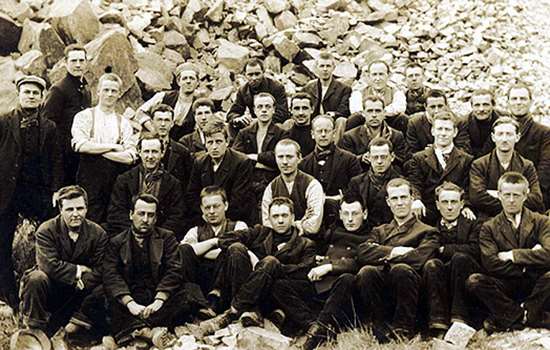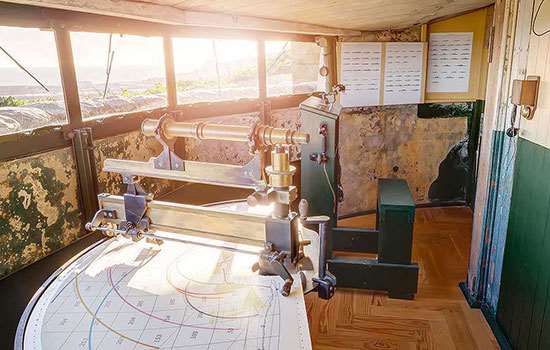An ordinary morning
On 16 December 1914, Britain had been at war for four months. In Scarborough, just before 8am, people were getting up and going about their routines. Mothers woke their children, maids prepared breakfast, postmen and delivery drivers were out on the streets. As shops opened for business, a young Boy Scout ran to buy a newspaper to see if there was a report on Lord Baden-Powell's recent visit to the town.
Up at the castle, on the rocky promontory overlooking the town, Police Constable Hunter was on duty with two coastguards at the coastal station. Despite their elevated position, their view was hampered by heavy mist and fog.
Anchored in the bay below was the steam trawler St Cloud. Her captain had sailed into the bay earlier that morning, and was having trouble finding the town because of the fog. The lighthouse had not been lit since war was declared.
The shelling begins
The captain of the St Cloud was among the first to see the three warships as they rounded Castle Hill into the bay, heading swiftly and surely towards Scarborough. He was surprised to see what he at first took to be British warships far closer to the shore than any he had seen before. But his surprise soon turned to horror when he saw one of them hoist the German war flag and open fire on the undefended town. A few minutes later, further up the coast, German warships also began an attack on Hartlepool, which had a garrison and three naval guns.
As soon as the St Cloud’s captain realised that the ships were German, he fled into the harbour and, although fired at, managed to reach it safely. The Germans, however, had their sights on other prey – with the castle being one of their main targets.
The castle under fire
There has been a castle at Scarborough since the mid-12th century, occupying a commanding position that had been inhabited and fortified intermittently since Neolithic times. It became one of the great medieval fortresses of England, ranking with Dover and Nottingham in importance. Before 1914, its greatest time of trial came when Parliamentarian forces besieged it in 1645, during the Civil War. So intense was that assault that during a three-day bombardment the walls of the 12th-century great tower split in two, causing half the building to collapse.
Now, as the Germans trained their guns on the castle, the coastguards’ lookout shelter was destroyed.
The coastguards and PC Hunter had only left it moments earlier to summon help, but as shells rained down, they were forced to shelter beside an 18th-century water tank in an underground vault. The castle’s great tower and south-facing walls were damaged and an 18th-century barracks built into the ruins of a medieval royal lodging was damaged beyond any hope of repair.
The attack on the town
Meanwhile, in the town, more than 500 high explosive shells fell in about 20 minutes, inflicting terrible damage on buildings of every description – shops, houses, hotels, churches, schools and hospitals. The German ships then moved off at speed towards Whitby, which suffered a brief bombardment.
In total, 17 people were killed in Scarborough that morning, with two others dying later of their wounds. More than 80 were seriously wounded. Overall, in Scarborough, Whitby and Hartlepool, 137 people died.
Although Hartlepool suffered more casualties and greater destruction, it was the civilian deaths in Scarborough that caused the greatest outrage. News soon spread of those who had been killed going about their everyday lives. The victims included postman Mr Beal, as he delivered letters, and maid Miss Crosby, as she prepared breakfast for her employers. The last person to be hit was 15-year-old George Taylor, on his way to buy his newspaper. He was the only Boy Scout to be killed in the First World War.
Aftermath
A popular seaside resort, Scarborough had no defences, only an ancient castle and a small naval wireless station. One US reporter wrote:
Three quiet, peaceful towns have felt the rain of shells; almost five score non-combatants, men, women, children perhaps, have met death from hurtling missiles. This is not warfare, this is murder.
As First Lord of the Admiralty, Winston Churchill faced criticism for the lack of preparedness and ineffective response of the British Navy. In a rousing speech, he branded the Germans ‘the baby killers of Scarborough’.
It was a mark of the outrage felt at the attack on defenceless civilians that ‘Remember Scarborough!’ became a rallying cry for recruiting officers across the nation. The attack featured on a range of recruitment posters, which prompted men to enlist in large numbers.
In this, the fourth month of the First World War – the war that people believed would be over by Christmas – innocence was shattered, as the war was brought right into the undefended homes of British people. The shelling of Scarborough was a foretaste of what was to come.
Related content
-

History of Scarborough Castle
Read a full history of the castle, from its origins in the mid-12th century through its dramatic Civil War siege to the present day.
-

The Richmond Sixteen
How 16 First World War conscientious objectors detained at Richmond Castle were taken to France and sentenced to death for refusing to obey orders.
-

The WWI Stonehenge aerodrome
As they travel from the Stonehenge visitor centre to the stones, few of today’s visitors realise that they’re crossing the site of a WWI airfield.
-

FORTRESS DOVER AND THE FIRST WORLD WAR
Use this virtual tour to explore a building at Dover Castle that played a vital role in safeguarding Dover in the First World War.
